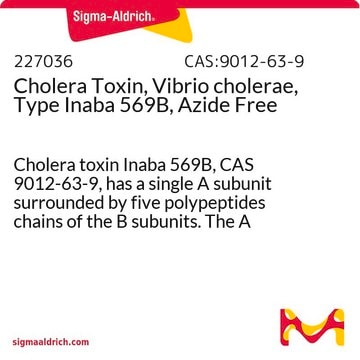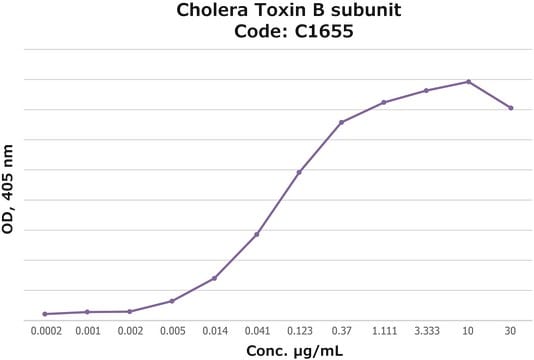C8052
Cholera Toxin
from Vibrio cholerae, ≥90% (SDS-PAGE), lyophilized powder, A-B type toxin
Synonym(s):
CTX, Cholera enterotoxin, Choleragen
About This Item
Recommended Products
product name
Cholera Toxin from Vibrio cholerae, ≥90% (SDS-PAGE), lyophilized powder
Quality Level
Assay
≥90% (SDS-PAGE)
form
lyophilized powder
composition
Protein, ~5% Lowry-TCA
solubility
H2O: 10 mg/mL
storage temp.
2-8°C
Looking for similar products? Visit Product Comparison Guide
General description
Cholera toxin and its A subunit are commonly used to study signal transduction mechanisms due to their impact on adenylate cyclase. Additionally, cholera toxin acts as an adjuvant by stimulating B lymphocytes and T helper cell type 2 responses by inhibiting interleukin-12 production. The non-toxic B subunit (CTB) attaches to cells by binding to ganglioside GM1, making it a useful label for microglial cells in neurological research. It has also proved to be an excellent tracer for axonal transport studies using immunohistochemical methods.
Application
Features and Benefits
Packaging
Physical form
Reconstitution
Signal Word
Danger
Hazard Statements
Precautionary Statements
Hazard Classifications
Acute Tox. 2 Dermal - Acute Tox. 2 Oral - Acute Tox. 4 Inhalation - Aquatic Chronic 3
Storage Class Code
6.1A - Combustible acute toxic Cat. 1 and 2 / very toxic hazardous materials
WGK
WGK 3
Certificates of Analysis (COA)
Search for Certificates of Analysis (COA) by entering the products Lot/Batch Number. Lot and Batch Numbers can be found on a product’s label following the words ‘Lot’ or ‘Batch’.
Already Own This Product?
Find documentation for the products that you have recently purchased in the Document Library.
Customers Also Viewed
Articles
Cyclic nucleotides like cAMP modulate cell function via PKA activation and ion channels.
Cyclic nucleotides like cAMP modulate cell function via PKA activation and ion channels.
Cyclic nucleotides like cAMP modulate cell function via PKA activation and ion channels.
Cyclic nucleotides like cAMP modulate cell function via PKA activation and ion channels.
Our team of scientists has experience in all areas of research including Life Science, Material Science, Chemical Synthesis, Chromatography, Analytical and many others.
Contact Technical Service








